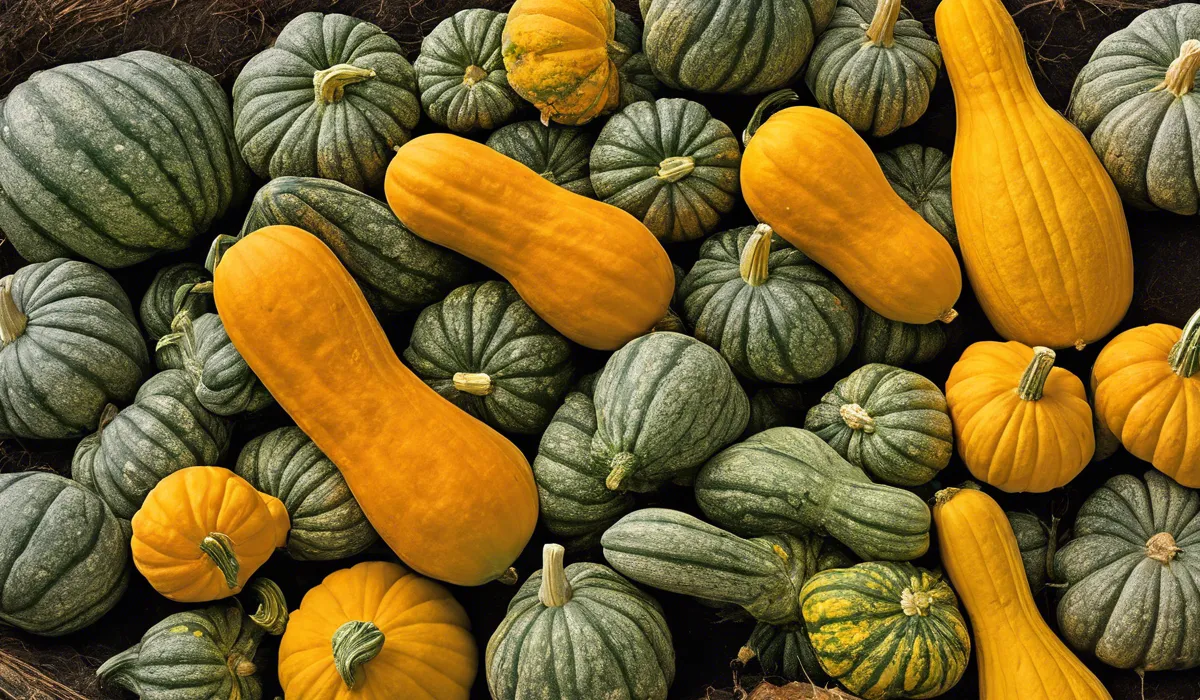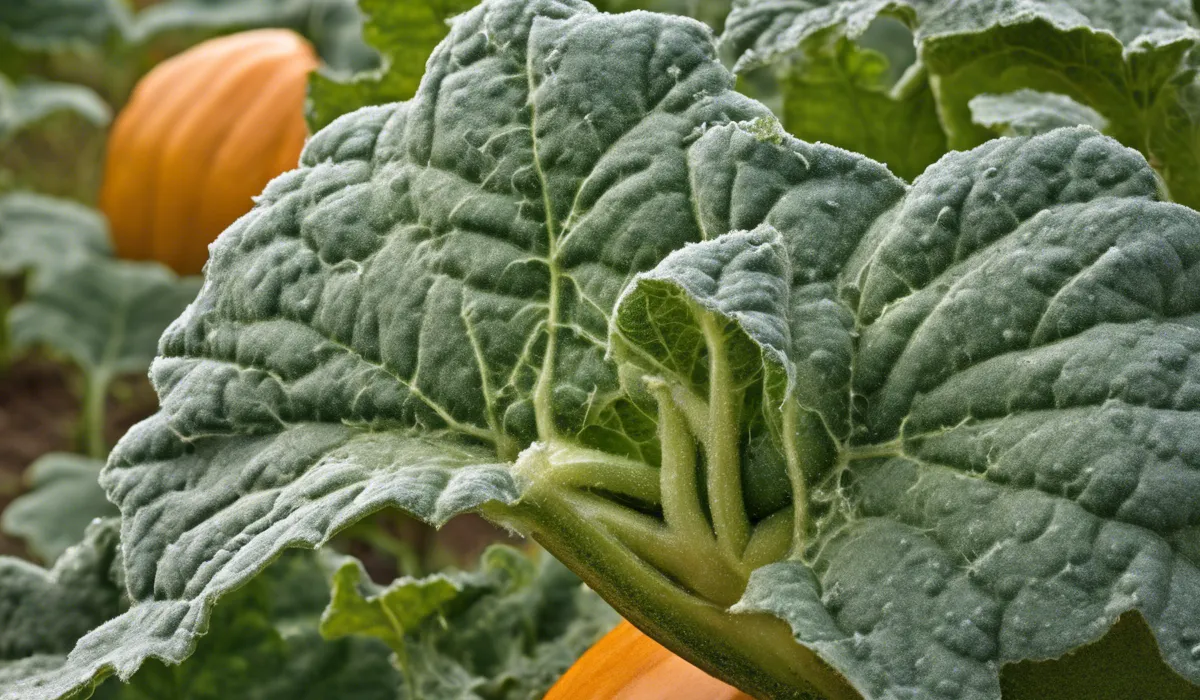To treat powdery mildew on squash, remove affected leaves and dispose of them. Apply a mixture of 1 part milk to 9 parts water to the plants every 7 days. Alternatively, use a fungicide containing potassium bicarbonate. Ensure good air circulation and avoid overhead watering.
Understanding Powdery Mildew on Squash

Definition of Powdery Mildew
Powdery mildew is a common fungal disease that affects many types of plants, including squash.
It appears as white or gray powdery spots on the leaves and stems of plants. This fungus thrives in warm, dry conditions with high humidity, and it can spread rapidly if not controlled.
Common Symptoms and Signs of Infection on Squash Plants
When squash plants get infected by powdery mildew, you’ll notice white or gray powdery spots forming on the upper parts of the leaves.
Over time, these spots grow, and if the disease gets worse, the leaves can turn yellow, dry out, and fall off. Sometimes, the mildew can also appear on the squash fruits and stems.
Conditions That Favor the Growth of Powdery Mildew
Powdery mildew loves warm days and cool, damp nights. It doesn’t need water on the leaf surfaces to grow, which makes it different from many other plant diseases.
When plants are crowded, and the air doesn’t move well between them, this disease can quickly take hold.
Lifecycle of the Fungus Causing Powdery Mildew
This fungus goes through a cycle that starts with spores landing on the plant. The spores grow and form a thin layer on the plant’s surface, which disrupts the plant’s normal functions.
As the fungus grows, it produces more spores, which can spread to other plants by the wind, insects, or gardening tools.
Potential Impact on Squash Plant Health and Yield
Powdery mildew can weaken squash plants by interfering with photosynthesis, which is how plants make their food.
If the disease isn’t treated, it can lead to fewer squash and smaller fruits. In severe cases, the plant might not produce any fruit at all, and the quality of the squash can be reduced, affecting both gardeners and farmers.
Preventative Measures Against Powdery Mildew

Selecting Resistant Squash Varieties
One of the best ways to avoid powdery mildew is to plant squash varieties that are resistant to the disease.
These plants have been bred to fight off the fungus better than others. When you’re choosing seeds or plants, look for ones that say they’re resistant to powdery mildew.
Proper Planting Practices to Reduce Humidity and Increase Air Circulation
Planting squash with enough space between them helps air move freely, which keeps the leaves dry and reduces the chance of powdery mildew.
Also, planting in a sunny spot helps because the sun can keep the plants dry and less likely to get the disease.
Importance of Crop Rotation and Sanitation
Changing where you plant your squash each year can stop diseases from building up in the soil.
Also, cleaning your gardening tools and getting rid of plant waste properly can prevent the spread of powdery mildew spores.
Utilizing Organic Mulches and Compost
Healthy plants can fight off diseases better. Using organic mulch and compost helps keep the squash plants strong and less likely to get sick.
Mulch can also keep the soil moisture even, which is good for the plants.
Watering Techniques to Minimize Leaf Wetness
Water your squash plants at the base instead of from above. This keeps the leaves dry and helps stop powdery mildew from growing.
Watering in the morning is best so any water that does get on the leaves can dry quickly in the sun.
Monitoring and Early Detection Strategies
Check your squash plants often for signs of powdery mildew. Catching the disease early means you can treat it before it spreads too much.
Look for the white or gray powdery spots on the leaves, especially when the weather is warm and humid.
Treatment Options for Infected Plants

Organic Treatments
For an organic approach to treating powdery mildew, you can use horticultural oils or sulfur-based fungicides, which stop the fungus from growing.
Another option is a homemade solution of baking soda and water. Spray these treatments on your squash plants to help control the disease.
Chemical Fungicides
If the disease is severe, you might need to use chemical fungicides. These are stronger and can be very effective.
It’s important to use them correctly, so always follow the instructions on the label. Remember to wear protective gear when you spray.
Home Remedies and Their Efficacy
Some gardeners use home remedies like milk solution or vinegar to treat powdery mildew. For the milk solution, mix one part milk with nine parts water and spray it on the plants every week.
These remedies can work, but they might not be as reliable as commercial products.
Pruning and Removing Affected Parts to Control the Spread
If you see leaves or stems with powdery mildew, cut them off and throw them away. This helps stop the disease from spreading.
Don’t put the infected parts in your compost because the spores can survive and spread the next time you use the compost.
Role of Biologic Controls and Beneficial Insects
Some bugs and other tiny creatures can help control powdery mildew by eating the fungus or competing with it.
Introducing beneficial insects to your garden can be a natural way to fight the disease and keep your squash plants healthy.
Ongoing Care and Maintenance to Prevent Recurrence
Keep taking care of your squash plants even after the powdery mildew is gone. Continue to use good watering practices, monitor the plants, and keep them healthy.
This will help prevent the disease from coming back and ensure you get a good harvest of squash.
FAQs About Treating Powdery Mildew on Squash
How can you initially treat powdery mildew on squash plants?
Initially treat powdery mildew on squash by removing and disposing of affected leaves to prevent further spread of the disease.
What is a natural remedy for powdery mildew on squash?
A natural remedy for powdery mildew on squash is to apply a mixture of 1 part milk to 9 parts water to the plants every 7 days.
Can you use fungicides to treat powdery mildew on squash, and which one?
Yes, you can use fungicides to treat powdery mildew on squash; look for ones containing potassium bicarbonate.
What cultural practices can help control powdery mildew on squash?
To control powdery mildew, ensure good air circulation around squash plants and avoid overhead watering to reduce humidity.
How often should the milk and water mixture be applied to treat powdery mildew on squash?
The milk and water mixture should be applied to the squash plants every 7 days to effectively treat powdery mildew.
Final Thoughts
Effective treatment of powdery mildew on squash involves removing and disposing of the infected leaves.
A preventative spray can be made with a 1:9 milk to water solution applied weekly. Alternatively, potassium bicarbonate-based fungicides are effective.
To minimize disease spread, ensure plants have sufficient air circulation and use ground-level watering techniques.
